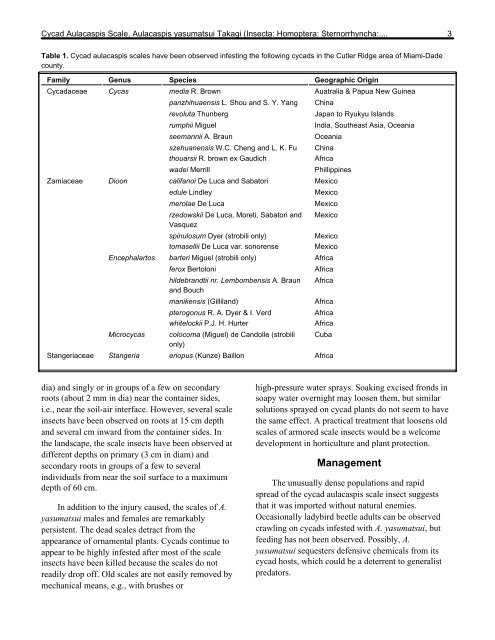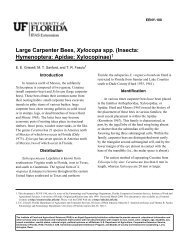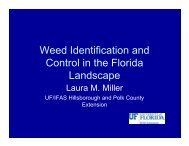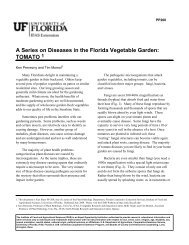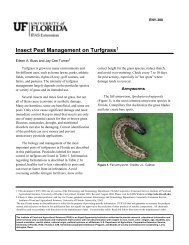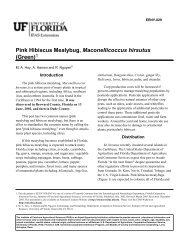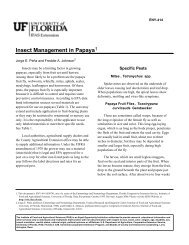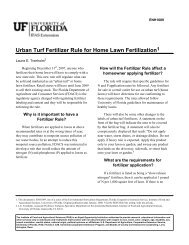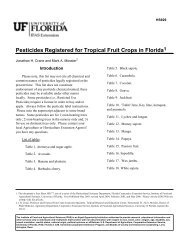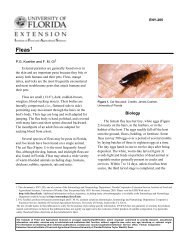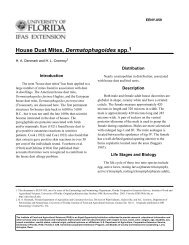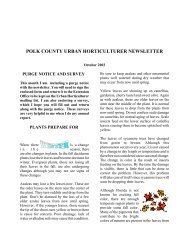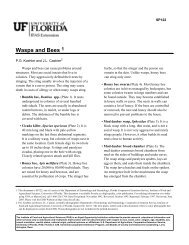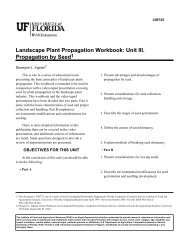Cycad Aulacaspis Scale, Aulacaspis yasumatsui Takagi (Insecta ...
Cycad Aulacaspis Scale, Aulacaspis yasumatsui Takagi (Insecta ...
Cycad Aulacaspis Scale, Aulacaspis yasumatsui Takagi (Insecta ...
You also want an ePaper? Increase the reach of your titles
YUMPU automatically turns print PDFs into web optimized ePapers that Google loves.
<strong>Cycad</strong> <strong>Aulacaspis</strong> <strong>Scale</strong>, <strong>Aulacaspis</strong> <strong>yasumatsui</strong> <strong>Takagi</strong> (<strong>Insecta</strong>: Homoptera: Sternorrhyncha:.... 3<br />
Table 1. <strong>Cycad</strong> aulacaspis scales have been observed infesting the following cycads in the Cutler Ridge area of Miami-Dade<br />
county.<br />
Family Genus Species Geographic Origin<br />
<strong>Cycad</strong>aceae Cycas media R. Brown Auatralia & Papua New Guinea<br />
panzhihuaensis L. Shou and S. Y. Yang China<br />
revoluta Thunberg Japan to Ryukyu Islands<br />
rumphii Miguel India, Southeast Asia, Oceania<br />
seemannii A. Braun Oceania<br />
szehuanensis W.C. Cheng and L. K. Fu China<br />
thouarsii R. brown ex Gaudich Africa<br />
wadei Merrill Phillippines<br />
Zamiaceae Dioon califanoi De Luca and Sabatori Mexico<br />
edule Lindley Mexico<br />
merolae De Luca Mexico<br />
rzedowskii De Luca, Moreti, Sabatori and<br />
Vasquez<br />
Mexico<br />
spinulosum Dyer (strobili only) Mexico<br />
tomasellii De Luca var. sonorense Mexico<br />
Encephalartos barteri Miguel (strobili only) Africa<br />
ferox Bertoloni Africa<br />
hildebrandtii nr. Lembombensis A. Braun<br />
and Bouch<br />
Africa<br />
manikensis (Gilliland) Africa<br />
pterogonus R. A. Dyer & I. Verd Africa<br />
whitelockii P.J. H. Hurter Africa<br />
Microcycas colocoma (Miguel) de Candolle (strobili<br />
only)<br />
Cuba<br />
Stangeriaceae Stangeria eriopus (Kunze) Baillon Africa<br />
dia) and singly or in groups of a few on secondary<br />
roots (about 2 mm in dia) near the container sides,<br />
i.e., near the soil-air interface. However, several scale<br />
insects have been observed on roots at 15 cm depth<br />
and several cm inward from the container sides. In<br />
the landscape, the scale insects have been observed at<br />
different depths on primary (3 cm in diam) and<br />
secondary roots in groups of a few to several<br />
individuals from near the soil surface to a maximum<br />
depth of 60 cm.<br />
In addition to the injury caused, the scales of A.<br />
<strong>yasumatsui</strong> males and females are remarkably<br />
persistent. The dead scales detract from the<br />
appearance of ornamental plants. <strong>Cycad</strong>s continue to<br />
appear to be highly infested after most of the scale<br />
insects have been killed because the scales do not<br />
readily drop off. Old scales are not easily removed by<br />
mechanical means, e.g., with brushes or<br />
high-pressure water sprays. Soaking excised fronds in<br />
soapy water overnight may loosen them, but similar<br />
solutions sprayed on cycad plants do not seem to have<br />
the same effect. A practical treatment that loosens old<br />
scales of armored scale insects would be a welcome<br />
development in horticulture and plant protection.<br />
Management<br />
The unusually dense populations and rapid<br />
spread of the cycad aulacaspis scale insect suggests<br />
that it was imported without natural enemies.<br />
Occasionally ladybird beetle adults can be observed<br />
crawling on cycads infested with A. <strong>yasumatsui</strong>, but<br />
feeding has not been observed. Possibly, A.<br />
<strong>yasumatsui</strong> sequesters defensive chemicals from its<br />
cycad hosts, which could be a deterrent to generalist<br />
predators.


